
Bird Facts & Information
A bird infestation at home raises concerns about property damage, health risks from droppings, noise disturbance, and the potential spread of diseases.
Risks of Birds
Property Damage
Pigeons and starlings can cause significant property damage. They may build nests in chimneys, vents, eaves, or other openings, which can lead to blockages and ventilation issues. Their nesting materials, droppings, feathers, and acidic droppings can corrode building materials, including metal, wood, and stone, causing deterioration and structural damage over time. The accumulation of droppings on roofs, ledges, and walkways can also become slippery and pose a slip and fall hazard.
Health and Sanitation Issues
Bird infestations can result in health and sanitation concerns. Pigeon and starling droppings can harbor bacteria, fungi, parasites, and viruses that can be harmful to humans. When dried bird droppings are disturbed, the dust particles can become airborne and be inhaled, potentially leading to respiratory issues. Additionally, the droppings can contaminate surfaces, food, and water sources, posing a risk of bacterial or fungal infections if proper hygiene measures are not followed.
Noise and Nuisance
Bird infestations can be noisy and disruptive. Pigeons and starlings are known for their vocalizations, which can be particularly bothersome when they gather in large numbers. The constant cooing, chirping, or squawking can cause disturbances, especially when they nest in or around residential or commercial properties. The noise can affect sleep, concentration, and overall quality of life for individuals in the vicinity of the infestation.
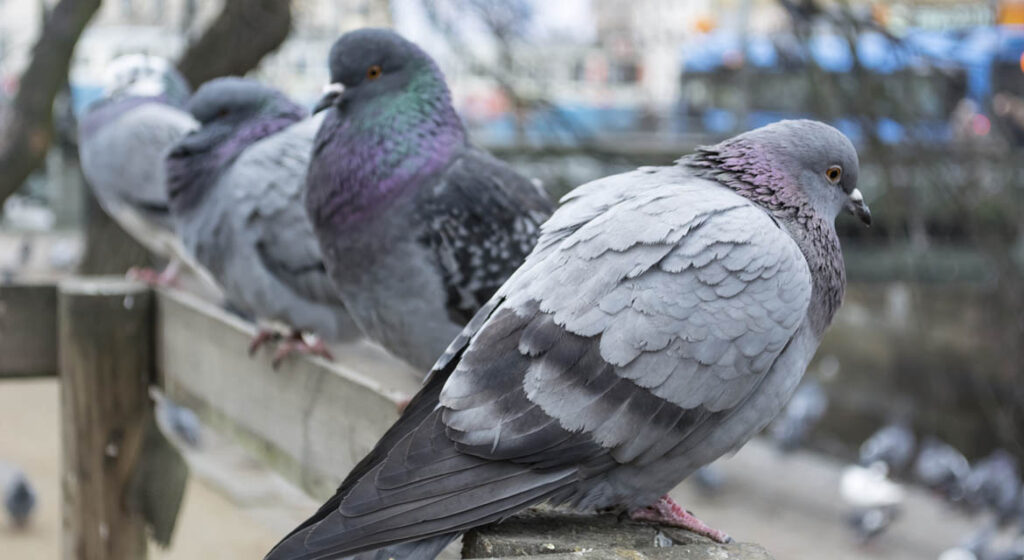
Truly Nolen GUARANTEE
If you’re not completely satisfied, you’ll get a full refund on your most recent service with our 100% money back guarantee.
Common Species of Birds

European Starling
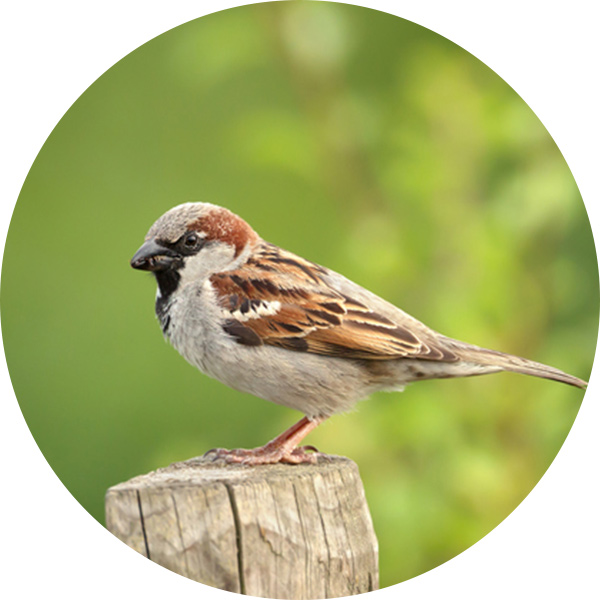
House Sparrow
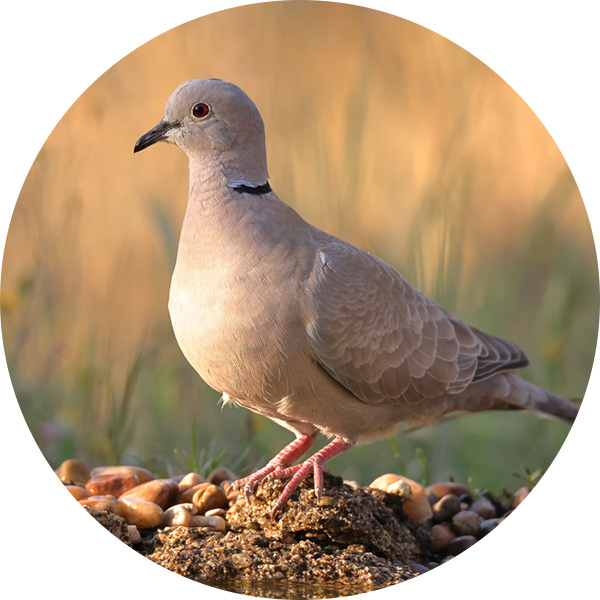
Eurasian Collared-Dove

Monk Parakeet
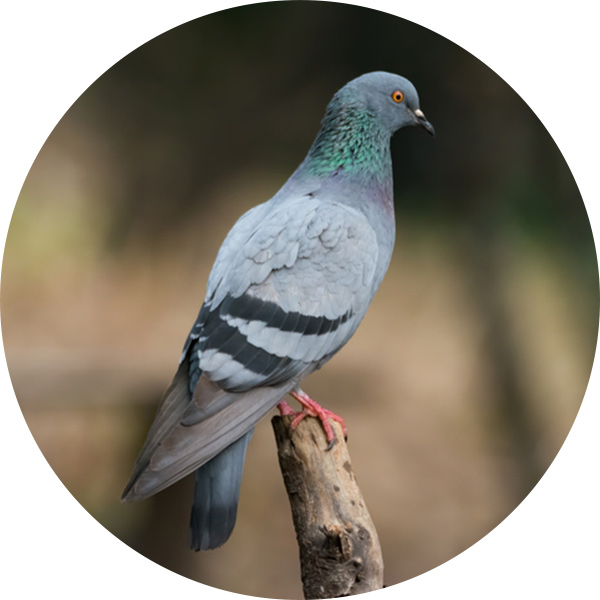
Rock Pigeon
How To Identify Birds
Birds can be identified by their unique physical characteristics, such as beak shape, feather patterns, and size, while a bird infestation at home can be identified by the presence of nests or roosting sites, bird droppings, feathers, and audible chirping or flapping sounds coming from within the premises.
Bird Appearance
Pigeons and starlings are both species of birds commonly found in urban and suburban environments. Pigeons are medium-sized birds with plump bodies, short necks, and small heads. They typically have gray feathers, although variations in color can occur. Starlings, on the other hand, are slightly smaller birds with pointed beaks and sleek black feathers. During breeding season, starlings develop iridescent plumage, which can appear speckled with white spots.
Bird Habitat
Pigeons and starlings are highly adaptable birds that thrive in a wide range of habitats. Pigeons are often found in urban areas, nesting on ledges, rooftops, and other structures. They are well adapted to human environments and can also be found in parks and gardens. Starlings, on the other hand, prefer open habitats such as fields, meadows, and agricultural areas. They are known for their ability to form large flocks and can be found roosting in trees, buildings, or other structures.
Bird Diet
Pigeons have an omnivorous diet, feeding on seeds, grains, fruits, and sometimes insects or small invertebrates. They are known to scavenge for food in urban areas, often relying on human food sources. Starlings have a diverse diet that includes insects, fruits, berries, and seeds. They are opportunistic feeders and can cause damage to crops in agricultural areas.
Bird Behavior
Pigeons and starlings are social birds that often gather in large flocks. Pigeons are known for their cooing calls and their ability to navigate and return to their roosting sites. They are adept at flying and can perform acrobatic maneuvers. Starlings are highly vocal birds, known for their complex songs and ability to mimic other bird species. They are also skilled fliers and can perform synchronized aerial displays known as murmurations.
Bird Reproduction
Pigeons are monogamous and form long-term pair bonds. They build simple nests using twigs and other materials, typically in elevated areas. Pigeons can breed throughout the year, with females laying one to two eggs per clutch. The incubation period lasts about 17 to 19 days. Starlings are also monogamous and breed during the spring and summer months. They build nests in cavities, such as tree holes or buildings. Female starlings lay four to six eggs per clutch, and the incubation period lasts around 12 days.
Bird Prevention
Preventing and controlling pigeons and starlings often involves a combination of habitat modification, exclusion techniques, and deterrents. Strategies may include sealing entry points to nesting sites, installing netting or spikes to prevent roosting, and using visual or auditory deterrents such as reflective devices or predator decoys. Maintaining clean environments, proper waste management, and reducing food sources can also discourage bird populations. It is important to follow local regulations and guidelines when implementing control measures, as birds are protected by laws in many regions.
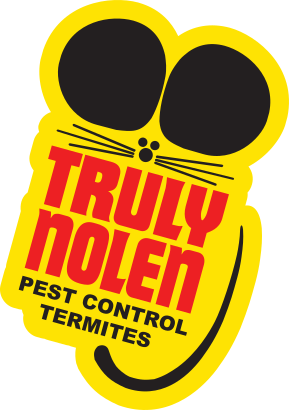
$50 Off Year Round Pest Control
Truly Nolen is a family-owned company with 85 years of experience providing the best pest control. If you’re not completely satisfied, you’ll get a full refund on your most recent service with our 100% money back guarantee.
The Truly Nolen Approach
Environmentally Conscious
We work to minimize our impact on the environment by using naturally occurring materials whenever possible.
Pet Friendly
Truly Nolen uses an Integrated Pest Management (IPM) approach designed with your pets in mind.
100% Money Back Guarantee
If you’re not completely satisfied, you’ll receive a full refund on your most recent service.
How Truly Nolen Gets Rid of Birds
Truly Nolen offers a comprehensive process for treating bird infestations that typically involves the following steps:
Inspection and Assessment: A trained technician will conduct a thorough inspection of your property to assess the extent of the bird infestation, identify nesting or roosting areas, and evaluate any factors attracting the birds.
Customized Treatment Plan: Based on the assessment, a customized treatment plan will be developed, taking into account the bird species, nesting locations, and the specific requirements of your property.
Bird Exclusion Methods: Truly Nolen employs various bird exclusion methods such as bird netting, bird spikes, bird wire systems, or bird repellents to deter birds from landing, roosting, or nesting in unwanted areas.
Nest and Dropping Removal: The technician will remove existing bird nests, droppings, and any debris associated with the infestation, using appropriate safety measures to prevent contamination and ensure thorough sanitation.
Cleanup and Sanitation: Proper cleanup and sanitation of affected areas will be performed to eliminate bird droppings, feathers, and other debris, reducing health risks and restoring a clean environment.
Maintenance and Monitoring: Truly Nolen may provide ongoing maintenance services to ensure the effectiveness of the bird exclusion methods and monitor for any signs of reinfestation. Recommendations for property modifications and bird deterrent strategies may also be suggested.
It’s important to note that the specific treatment process may vary depending on the type of bird infestation, property characteristics, and local regulations. Consulting with a Truly Nolen professional will provide you with accurate and detailed information tailored to your specific situation.
Frequently Asked Questions
Why are birds infesting my property?
Birds may infest properties seeking shelter, nesting sites, or food sources. Factors such as easy access to food, suitable nesting locations, or favorable environmental conditions can attract birds to your property.
Are birds a health risk, and can they spread diseases?
While birds themselves are not inherently harmful, their droppings can pose health risks due to the presence of bacteria, fungi, and parasites. Airborne particles from dried bird droppings can potentially cause respiratory issues. Certain bird species, such as pigeons, can also carry diseases like salmonella and ornithosis. Learn More!
How can I deter birds from nesting on my property?
To deter birds from nesting, you can implement bird exclusion methods like installing bird netting, bird spikes, or bird wire systems, removing food sources, using bird repellents, and modifying your property to eliminate potential nesting sites.
What should I do if I find a bird’s nest on my property?
If you find a bird’s nest on your property, it is generally recommended to leave it undisturbed until the nesting season is over and the birds have vacated. Removing nests during active nesting periods can be illegal and may cause harm to the birds.
Can I remove birds or nests on my own, or do I need professional assistance?
It is advisable to seek professional assistance for bird removal or nest removal to ensure compliance with local regulations and to address the infestation effectively and safely. Professionals have the knowledge, experience, and proper tools to handle bird infestations and implement appropriate exclusion measures. Learn More!

